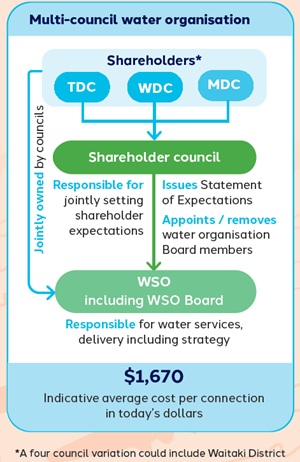 Our preferred option would see our Council join with others to form a new water services organisation.
Our preferred option would see our Council join with others to form a new water services organisation.
This organisation would handle water services across all participating districts and take on each council’s water-related assets and debt. The Company would be owned jointly by the partner councils.
A professional board of directors, appointed by the councils, would run the organisation day to day. While we and the other shareholding councils could guide the board and continue to make some key decisions, we wouldn’t control every aspect of the organisation’s work.
Over time, we expect this new organisation would bill customers directly for its services, but in the meantime, we expect that councils would continue to collect water revenues through rates bills, similar to how we bill on
behalf of Environment Canterbury.
Estimated costs
this is what ratepayers could expect to pay on average for water (drinking water, stormwater, wastewater) under the proposed option.
| 2025 | 2034 |
|---|---|
| $1,500 | $1,670 |
How would our district have a say in a joint water organisation?
If we do decide to join up with others, we will still get to make decisions about how the arrangement could work.
There are ways for us to monitor and direct the organisation to make sure that your water services are being delivered well and that our district’s needs are being met.
This would include:
Appointing the board of directors, jointly with the other councils, so we can make sure the board has the skills and experience we want.
Jointly issuing a Statement of Expectations, to set priorities for the organisation and specify how progress against them would be measured. The Statement would guide the organisation’s decisions and actions, and the organisation would need to give effect to the Statement and report against it.
Requiring regular reporting from the water organisation on how it’s performing, including through an annual report on progress, service standards, and financial performance.
Negotiating a number of additional protections to include in the organisation’s constitution, such as consulting with our community.
| Advantages | Disadvantages |
|---|---|
|
|
Last updated: 15 May 2025